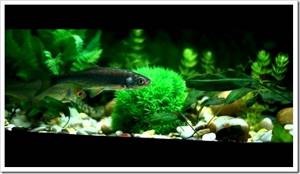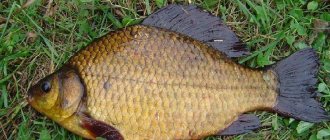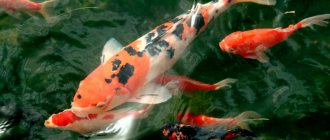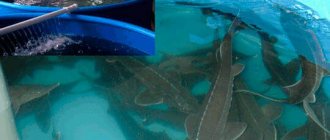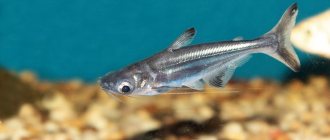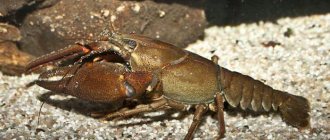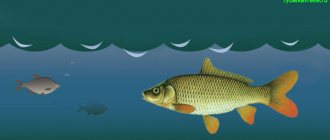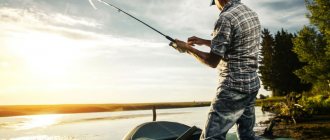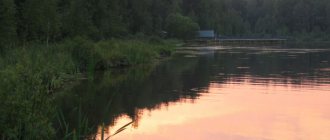Types of feed
Feeds are divided into artificial (granulated feed and feed mixtures) and live (account for 25-25% of the fish diet and includes natural live feeds). They are also divided into other criteria, which are described below.
By composition
The food must be selected according to its composition - it must contain certain nutrients and microelements.
- Proteins occupy an important place in metabolism. The protein content in the diet should be from 30 to 60% of the total amount of dry food. It is especially important to provide the right amount of protein to young animals. It contains essential amino acids and their absence can lead to decreased growth and disease. Protein foods include beef heart, chicken eggs, fresh frozen and boiled fish, shrimp and krill meat.
- Fats are the main source of energy, their deficiency will lead to a decrease in growth rates and cause physiological disorders. The need varies depending on the type of pet (for example, for carp - 1%, for eel and trout - no more than 0.5%). Fat is contained in various seeds (flax, for example) and cake.
- Carbohydrates - the amount should not exceed 25%, which is a complete source of energy, but the need for different types of fish is different. For example, for carp or eel, a high fiber content threatens to slow growth and increase the fat content of the meat. Also, the amount of carbohydrates should be calculated not only by breed, but also by age of the fish. Contained in plant and grain raw materials.
- Minerals – some minerals (calcium, phosphorus, chlorine) are obtained by fish from the water. The rest must be given to them artificially, carefully selecting elements of the diet. If there is a slight lack of minerals, then this affects the growth rate, but if there is a severe deficiency, then this ends in a decrease in appetite or even the death of the young. Fish get minerals from plants and algae.
- Vitamins - all vitamins are responsible for certain processes in the body - vitamin A controls the state of metabolism, D is responsible for the formation of bones, E - promotes the formation of caviar. But vitamin B is considered especially important, with the help of which proteins and carbohydrates are absorbed. The source of vitamins is live food - insects, crickets, dodrophila flies.
Depending on the type of fish
Fish have their own feeding habits - some feed in the upper layers of water, others in the lower, and others in the middle. And it is on the basis of these physiological characteristics that feed is selected:
- Fish are surface feeders - feed them food in the form of chips, sticks and flakes as they are light in weight and help keep them afloat.
- Fish in the middle layers of water can also eat cereal and chips, because when wet they become heavier and sink lower to the bottom. Another solution is pellets, as they sink slowly, allowing the fish time to eat them.
- Fish on the bottom - eat pellets, tablets and wafers. They are heavier than chips and immediately begin to sink to the bottom.
By manufacturer
When choosing food, you should pay attention to high quality food that has proven itself in the market. Some of these foods have a healing effect:
- Tetra is a leader in the production of products for aquariums and garden fish farming. The following types are offered for cold-water fish: Tetra pond sticks – universal food for pond fish in the form of floating sticks. The price varies depending on the packaging of the feed. For example, a 1 liter jar (that’s 100 g of food) costs 250 rubles.
- Tetra pond sticks mini – granulated food for small pond fish (up to 15 cm) and fry. The price is about 350 rubles for a 1 liter jar (this is about 135 g of food).
- Tetra goldfish (Goldfish, Goldfish Granules, Goldfish Pro, Goldfish Color, Goldfish Energy Sticks) – flakes and sticks for goldfish. Price - from 50 to 3,500 rubles, depending on packaging and type of food (for example, for a jar with a capacity of 1 liter you will need to pay 700-1,000 rubles).
- Tetra pond holiday is a “long-lasting” food for pond fish during holidays (provides fish with nutrients for 14 days). Price – 260 rubles for 98 g.
- JBL NovoRed – food in the form of flakes. Price - from 700 to 1200 rubles per jar with a capacity of 1 liter (190 g of feed). JBL NovoRed refill will cost much less , which is sold in a spare package at a bargain price (450 rubles for 750 ml/135 g).
- Aller ArtEx is a premium food for sturgeon, whitefish and pike perch.
Aller Parvo EX is a starter food for carp.
A 25 kg bag costs from 2300 to 5500 rubles.
Introduction
With this article we will try to cover the topic of freshwater fish nutrition, which is deeply reflected in most recreational fishing processes. Knowledge in this area will never be superfluous and will help protect readers from fishing mistakes, especially related to the choice of the following priorities:
- — between animal baits and plant baits,
- - the size of the hook and the bait on it,
- — fishing depths (bottom, middle, top) when searching for fish,
- - fishing method and corresponding gear.
In the article we will talk about: what different types of fish eat, in which layers of reservoirs they look for food, how the diet of individual species differs and how they are divided according to these and other characteristics. We will also consider the external signs of the structure of fish, indicating their lifestyle, feeding patterns and feeding horizons (layers). Let's also touch on some other aspects of fishing related to the nutrition of the silent inhabitants of the aquatic latitudes.
How to choose the right food for your fish?
If your choice falls on ready-made food, then you should understand that not all of them are the same and healthy, so you should pay attention to some characteristics:
- Purpose of feed. Take balanced food for pond fish, not aquarium fish;
- Balance. The food must be balanced and include proteins, minerals, and vitamins to ensure healthy and complete nutrition.
- Digestibility. The diet you choose should be well absorbed and promote good digestion, as this will help keep the water clean for a longer time.
- Components. They must be selected, so there is no need to buy economy-class food made from low-quality raw materials, since this does not provide any nutritional value for the fish and accelerates water pollution with organic matter and the growth of algae due to poor digestibility.
- Package. You should not purchase food in bulk or in damaged packaging, as there is no guarantee that such food remains fresh or of high quality. The packaging must be made of dense material, not allow light to pass through and have a lock;
- Immune protection. Particularly useful food for fish are those that help increase the body's defenses.
Preparing the aquarium, transporting fish
When preparing for the introduction of river fish into a home aquarium, first of all, you should pay attention to the soil; small pebbles are best in this case.
The development of fish in a new place will be successful if, after catching, it is placed in water from its permanent habitat. And at home, new guests should be placed in an aquarium with 50% clean water and the same amount of water should be added from the reservoir.
In order not to injure the caught fish during transportation, you need to choose comfortable dishes (it is better to use wide and low ones). It is recommended to carry 4-5 copies in a 5 liter container.
If the journey is long, take care of temporary aeration for the fish; such a device can be made from a hose, a spray bulb and a sprayer.
Features of feeding
When growing fish in a pond, the feed requirements are slightly lower, because in natural reservoirs there is natural food that needs a little supplementation. Typically, fish food is introduced in the form of granules, briquettes or dough-like mass. Pay attention only to granules or briquettes, as they have high moisture resistance, while the dough-like mass will soon lose half of its useful substances.
In early spring, when the fish wakes up, feed it more nutritiously than in summer. In hot weather, the fish do not eat as much, as they can find food in the pond itself. And in the fall, when the water temperature drops below 10 degrees, stop feeding the fish completely, since in winter most species go into a dormant state.
Feeding place
The feeding regime is influenced by the habitat/keeping of the fish. This can be a private pond, a natural or artificial reservoir. If the reservoir is large, then the feeding place is marked by placing a pole or a floating buoy.
The fish are fed at the same time so that the fish develops a conditioned reflex to the place and time of food intake - this prevents the food from becoming soggy and washed out. They feed fish in the coastal zone. The optimal depth is 60-80 cm.
Private ponds
If fish are raised in a natural reservoir, the requirements for feed are not as stringent as when raising livestock in artificial ponds. Natural ponds contain a variety of plankton, which are supplemented with granules or dough-like feed.
Preference is given to granulated feed and briquettes - these types of feed are characterized by good moisture resistance. Dough food is inferior to granulated food at this point - after an hour it loses 50% of its nutritional value.
When growing fish in cages and pools, the feeding is 100% artificial. The selection of feed and calculation of norms should be approached especially seriously - the efficiency of the fish farming business depends on correctly selected feed.
In the country
Fish bred in small country ponds should be fed regularly. There is no food supply here or it is very scarce. In order for fish to grow, gain weight and reproduce, they need artificial food.
The food is given in doses. If you provide more food than required, the fish will not eat it and the pond water will become polluted. Dirty water will cause oxygen starvation in the inhabitants of the pond, their immunity will decrease, and they will begin to get sick. It is not recommended to scatter food over the surface of the pond; special feeders are provided for feeding.
You can see what they feed fish in country ponds in the video below:
The following article will tell you what kind of fish can be bred at your dacha or farm.
How to feed fish correctly?
While the feeding process is taking place, you need to observe how the fish eats the food. The amount of food should be such that there are no leftovers. If what the fish were unable to eat accumulates, then the feeders and pond need to be cleaned, otherwise the remains will begin to decompose and contribute to the development of pathogenic microorganisms.
The state of appetite is assessed about 40-60 minutes after the food has been distributed.
Rules
In order for feeding fish to give the desired result, you must adhere to the following rules:
- Don't just throw dry food on the bottom of the pond. Add a little water to it and make the consistency of a thick dough, and only then add it to the pond.
- Feed the fish at the same time to develop their reflex.
- When feeding in the evening, add lighting so that the fish begin to reflexively react to this light, which will simplify the catching process in the future.
- Provide the feeding area with a metal tray made of galvanized iron and equip it with a lifting device. This is necessary in order to raise and lower the tray into the pond at any time and monitor the process of eating food. You can also regulate the amount of food dispensed and ensure that the food does not begin to rot or sour, which will help maintain the purity of the water.
More information about feeding pond fish is written here.
Compliance with conditions
Feeding fish in a pond depends on a large number of factors, which include:
- Water temperature - in the summer months, if there is a large natural food supply, feeding occurs 2-3 hours after the sun rises. The water temperature should be from 12-15 degrees and above;
- Age – Fledglings need to be fed twice a day – morning and evening, in small portions. Two-year-olds are fed once a day - in the morning.
- Eatability - in order not to overfeed the fish, you need to monitor the rate of food disappearance. If the food is eaten too quickly, it means the fish are not getting the amount of food they need. If the food remains untouched for three hours, then it is worth reducing the norm.
External signs of the feeding method of fish
The structure of their body, its shape and the location of its individual parts: fins, head, eyes, mouth.
Fish with a round, torpedo-shaped body are very mobile (chub, trout, barbel), well adapted to the current, and slow-moving species that live in standing or slowly flowing waters have a laterally compressed body (bream, roach, sabrefish), which helps them maneuver easily between plant stems in areas with dense vegetation.
Fish with a highly developed dorsal fin, or even two instead of one, stretched across the entire back (perch, bersch, pike perch) are very fast and strong swimmers. They are active predators, and this structure of the dorsal fins helps them quickly and confidently overtake their prey.
But the most striking sign that makes it possible, with a fleeting visual contact, to determine at what level a given fish is feeding, is the shape and location of its mouth.
As can be seen from the picture:
- lower mouth - the upper jaw is longer than the lower jaw, emphasizing the bottom existence of its owner;
- owners of the upper mouth -
the lower jaw predominates over the upper; they prefer to feed in the upper layers;
- terminal mouth - located at the end of the snout (front of the head) with jaws of the same length speaks of the wide capabilities of its owner, allowing him to feed wherever he wishes.
In addition to the distinct shapes of the mouth, there are weakly expressed variants of its structure:
semi-inferior mouth - the upper jaw is slightly longer than the lower jaw; fish search for and eat food both in the bottom layer and in the water column.
semi-upper mouth - the lower jaw is slightly larger than the upper jaw. Peaceful individuals with such a mouth can obtain food in the upper and neutral horizons, and this mouth structure does not limit the possibilities of predators.
The belonging of the fish to the order of predators is evidenced by the teeth, which in some species of predatory individuals are located not only on the jaws, but also on the tongue and palate.
In peaceful fish, the absence of teeth in the oral cavity is compensated by the presence of pharyngeal teeth. The pharyngeal teeth are divided into upper and lower. The lower ones are located on the fifth gill arch, transformed into a bone plate and look like platforms strewn with small denticles.
With the lower pharyngeal teeth, together with the upper teeth, which represent a horny formation on the upper wall of the pharynx, fish hold and grind food, even very hard ones. For example, a chub freely grinds the shells of crayfish and mollusks with its pharyngeal teeth.
Feeding regimen for different fish
The differentiation of fish by species plays an important role in feeding efficiency, since each food has specific nutritional requirements.
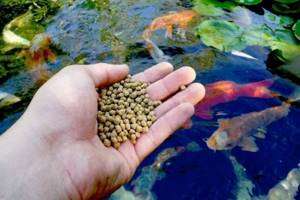
Carp
The daily feed requirement for carp breeding is determined by the weight of the fish and the water temperature. If the weight of the carp is up to 0.5 g, then the daily norm is 100% of the weight, if 500 or more, then 2.8% of the total weight.
Fingerlings and two-year-olds are fed pellets, which are placed in special feeders. The young are fed every hour, reducing the amount of food given as they gain weight. Also, the number of feedings decreases when the water temperature drops. You can feed carp with protein food (worms, bloodworms, snails and shells), potatoes, cake and bread, as well as finely chopped soft grass and special feed (which it is advisable to pre-mix in a bucket until a dough-like mass is formed).
If the water in the pond is very warm - 23-26 degrees, then the fish's appetite increases and they need to be fed more often. Feed the young almost every hour. It is enough to feed carp weighing from half a kilo to 2 kg 4-5 times a day. If the water temperature is 22-24 degrees, then the number of feedings reaches 5-6 times a day, if 14-20 degrees, then 4 times a day, and at temperatures less than 14 degrees - 2-3 times a day.
crucian carp
Crucian carp is a fish that is considered almost omnivorous. Nothing will happen to her, even if you forget to feed her, because in reservoirs she will always find the necessary minimum of food, especially if an ecosystem has already formed in the pond.
Crucian carp eat best algae, steamed beans and cereals, worms, insect larvae, and bloodworms. It is not advisable to feed bread.
The amount of feed introduced should be no more than 5% of the weight of the fish. Calculating the norm is simple - if about 30 individuals of 200 grams each live in a pond, then the total weight of the fish is 6 kg, which means that the one-time feed norm should not exceed 300 grams.
Feed the crucian carp 1-2 times a day, at the same time.
Read about breeding crucian carp, including feeding them, here.
Salmonidae
Fish of the salmon family are fed with meat waste, low-fat dry milk, as well as meat and bone, fish and krill meal. These components can be mixed with each other or you can immediately buy ready-made feed, which differ by age group: for example, for fry weighing up to 5 grams, take RGM-6M and S-112-Lat, and for young animals - LK-5P.
Som
Catfish is a special fish, since by the time it begins to eat properly, its stomach and intestines have already developed, which makes it possible to form special enzymes for digesting food. This feature makes the fish less demanding on the composition of the feed - for catfish, SB-1 and SB-3 are usually used, supplementing them with calcium if rearing occurs in soft water.
You need to feed catfish fry 8 times a day, gradually reducing the number of meals to 4 times. The volume of a single dose of food depends on the temperature of the water - the warmer the water, the more food you need to give.
Acne
To successfully breed young fish, you need to monitor the amount of animal proteins in the eel’s food; the more there is, the more intensive the growth of the fish. The young are fed up to 10 times a day in the shaded parts of the pond and use mainly animal feed for feeding. For fish weighing up to 2 grams, the daily norm is 16%, weighing 2-4 grams - 12%, 4-8 grams - 10% and 8-25 grams - 8%.
Sturgeon
Sturgeon need to be given food with a high fat content, this is especially important for juvenile besters. The number of feeding times depends on age: larvae and fry are fed up to 12 times a day, and adult fish - from 4 to 8 times a day.
tilapia
For tilapia, feed of both plant and animal origin is excellent, and protein foods are a priority.
Grain waste, meal and mixed feed are suitable for feeding tilapia. The larvae begin to consume artificial food as soon as they switch to active external feeding and therefore they are excellent for breeding in pools and ponds.
For juveniles weighing up to 50 grams, take feed VBS-RZh-81, RZGK-1, and weighing from 50 grams and above - PK-Vr, RGM-2Ke, etc. The food supply per day is determined based on the weight of the fish.
Amazing feature of these fish
As we have already noted, food for crucian carp in ponds and lakes depends on their depth: the deeper the reservoir, the more nutritious the food, which means the larger the fish. But scientists who studied these creatures in the laboratory for a long time could not understand how crucian carp manage to notice live food that falls to the bottom beyond their “view sector.”
It turned out that a special side line helps them with this. Almost all fish on earth have it. Externally, this lateral line looks like a stitch running from the head to the tail of the fish. It is thanks to this feature that the brain of crucian carp is able, in a matter of fractions of a second, to register the slightest vibrations emanating to the sides from small edible living creatures. So the fish eat heartily and thoroughly.
What determines the effectiveness of feeding?
The conditions in which fish are grown have a direct impact on the growth rate and quality of fish meat. An important point is water temperature - a large number of species increases their growth rate when the water temperature in the reservoir rises. If the readings drop to 0 degrees, then food digestion first slows down, and a little later the process stops altogether.
The quality of food also matters (protein food accelerates the growth of fish) and the amount of oxygen in the water (a value of 1 mg/l is too low for fish, and it stops growing and eating). The big disadvantage of low oxygen levels is the increase in ammonia and nitrate concentrations, which also negatively affects growth.
Take care about the length of daylight hours. Since daylight hours tend to decrease with the approach of colder seasons, it makes sense to use artificial lighting to stimulate the production of growth hormone and improve food digestion.
Keep an eye on the salt level in the water because some fish species can only be kept in either fresh or salt water. The exception is tilapia, as it can grow in any type of reservoir.
To dispense food, use special feeders that you can make yourself. You will find detailed instructions on how to make such a feeder in this video:
What kind of reservoir should a body of water be in order to grow fish in it?
If you already have a reservoir at your dacha - it could be a stream with a dam built on it, or something else, then you are very lucky. For those who don’t have this, you can read the article further, because making your own pond is quite possible.
The suitable dimensions of your pond can be somewhere around 4x6 m, with a depth of 1 to 1.5 m. This is the optimal depth, since the water in such a reservoir will heat up well to a temperature of 25 degrees, which is quite enough for the good development and habitat of small crucian carp, the number of which can reach a couple of dozen with a weight of 250 g.
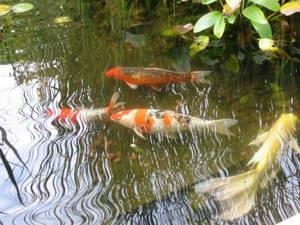
The size of farmed crucian carp is directly proportional to the size of the reservoir itself
Before introducing animals into the pond, it is necessary to adjust the temperature so that it is the same as in the previous reservoir. Otherwise, even a difference of 3 degrees can destroy the fauna.
Crucian carp for a home pond (video)
If you are planning to breed crucian carp, it is important to consider one point - there are two types of it - golden and silver. The second type develops more productively, and its mass is rapidly gaining. Therefore, we recommend farming silver crucian carp.
We also recommend reading
- Landscape design of a small summer cottage
- Layout of a plot of 12 acres
Male silver crucian carp are found quite rarely. Females are the main offspring of crucian carp. However, this does not slow down the spread of the species at all, since neighboring males are quite suitable for this task. To breed crucian carp, it is enough to have females aged 4 years, who have a compressed side and a tall body - they have fairly healthy offspring that develop quickly.
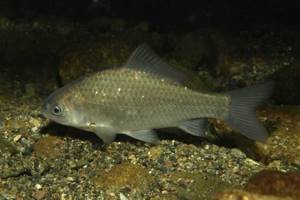
Silver crucian carp is recommended for a home pond
Self-preparing food
There are situations when it is not possible to purchase ready-made food. In such cases, you can always prepare it yourself.
For example, you can make a long-term storage feed mixture, which will include the following components:
- fishmeal – 15 parts;
- shrimp – 5 parts;
- dried bloodworms – 5-10 parts;
- boiled egg – 5 parts;
- dry daphnia, cyclops and gamarus - 5-10 parts;
- powdered milk – 5-10 parts;
- bread crumbs;
- red bell pepper (for coloring) – 5 parts;
- underwater plants;
- yeast – 6-10 parts;
- shoots of nettle, dandelion and plantain scalded with boiling water - 10-14 parts.
All ingredients need to be ground and supplemented with multivitamins, then mixed in boiling water to a paste-like state and boil for another 2-3 minutes. Divide into molds and freeze. The dish is given to the fish both frozen and melted. Freshly cut herbs or ground green peas are used as a garnish.
Nutrition of fish is an important issue if you want them to live a long time and be pleasing to your eyes (when decorative breeding of koi carps, for example). Therefore, you should be very careful when choosing food, read the composition of ready-made feeds and do not hesitate to ask questions to more knowledgeable people who will help you figure it out.
0
2
Copy link
What river fish can live in an aquarium?
The range of representatives of rivers suitable for a home pond is quite large: carp, verkhovka, tench, rudd, etc.
Before populating the aquarium, you need to take into account that the most “resistant” fish will be from a body of water that is not flowing or has a weak current. Also, fish caught in the fall will be more resilient to the conditions of an artificially created habitat.
When settling river residents, it is necessary to take into account that coexistence of predatory and non-predatory fish is impossible.
Predatory animals (perch, pike, pike perch, catfish) need live fish for food, unlike non-predatory animals (bream, rudd, carp, crucian carp), which use plants and invertebrate animals as food.
Regarding the types of fish suitable for keeping at home, the most unpretentious representative is the crucian carp, which can “survive” even in the most difficult conditions.
It creates a special layer around itself consisting of water and dirt, and in such conditions it can last for about 2-3 months.
Therefore, crucian carp are the best option for keeping in a home pond. This fish loves a lot of vegetation and algae, so this must be taken into account when “populating” this inhabitant.
The most important condition is to create a habitat for the fish that is similar to their native one (rivers, reservoirs, ponds).
In order for the residents to feel free and comfortable, it is necessary to prepare a large aquarium with algae (duckweed, hornwort, trampweed, glitterweed), which can acclimatize in the conditions of a home pond.
